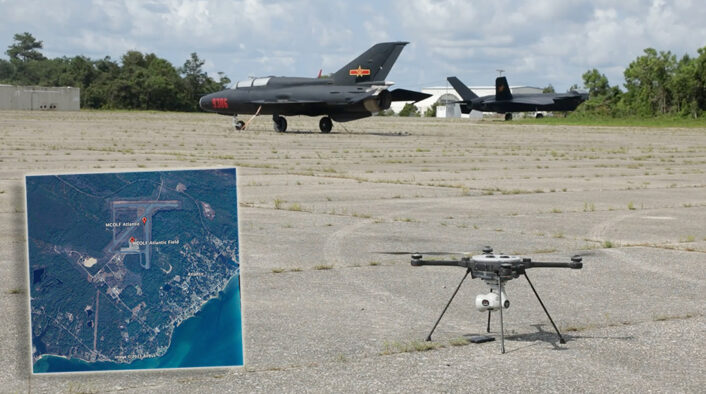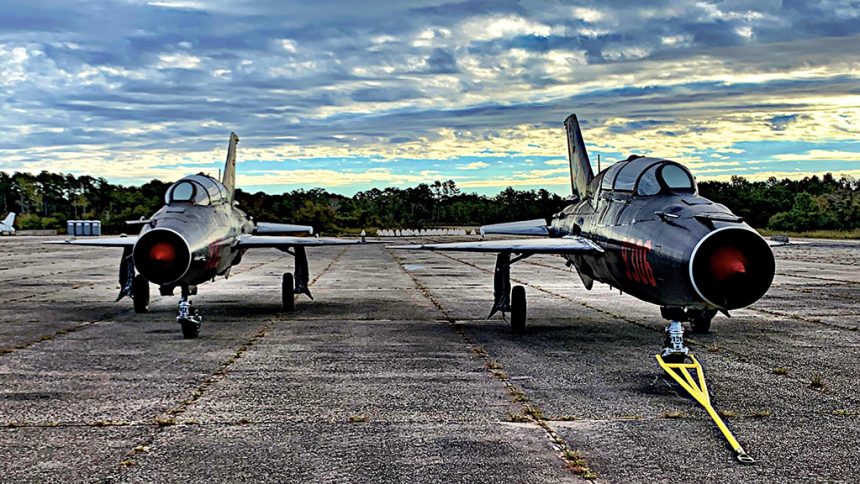We got some new exclusive details about the Chinese combat aircraft mock-ups used for training by the U.S. Marine Corps MCOLF Atlantic and other bases.
It’s not a secret that the U.S. Marine Corps use full scale replicas of Chinese jets at various airfields across the U.S. for visual and sensor training. In December 2018, we were the first to spot a Chengdu J-20 Mighty Dragon mock up parked in front of the USAF Air Dominance Center at the Savannah-Hilton Head International Airport, Georgia.
In the following days, we got the confirmation from the Col. Emmanuel Haldopoulos, Commander of the Savannah Air Dominance Center, that the aircraft, was “a full scale replica and remained at the Air Dominance Center for a short period during the week of 4-6 Dec [2018].
We heard nothing about the J-20 replica until 2020, when the mock up appeared in satellite images of Marine Corps Auxiliary Landing Field Bogue, or “Bogue Field”, an airfield that serves as a Marine Corps’ East Coast site for Field Carrier Landing Practice (FCLP) and carrier qualification.
The replica remained there until (at least) 2021 then it was disassembled and moved to another auxiliary airfield: Marine Corps Outlying Field (MCOLF) Atlantic, North Carolina, a facility that, among the other things, supports various training activities including tactical, air-to-ground, electronic warfare and low altitude exercises in the nearby ranges.
A video, shot during U.S. Marines Small Unmanned Aircraft System School’s activities with R80D SkyRaider Unmanned Aerial System in July 2023, showed the J-20 parked next to another Chinese fighter jet: a J-7. The presence of two Fishbed-derivative at MCOLF Atlantic Field was exposed in Google Earth imagery dated January 2023.

Interestingly, we were able to find out something more about these aircraft models thanks to the support of the USMC Training and Education Command. First of all, we learned that the J-7s are at MCOLF Atlantic Field, NC are actually real MiG-21 two-seat aircraft from Poland. The aircraft have been modified to represent Chinese J-7 fighter escorts for the J-20 stealth fighter also at Atlantic; all of them are equipped with engine plume replicators that provide an IR signature to the EO/IR sensors used in ISR (Intelligence Surveillance Reconnaissance) training.
Noteworthy, the Chinese jets are not the only threat surrogate/replicas the U.S. Marine Corps use for a more realistic training: the list of so-called HDTs (High Definition Targets) that mirror actual vehicle specifications and can be deployed at bases on the East and West Coast depending upon requirement, includes also the T-72 MBT (Main Battle Tank); ZBD-97 Chinese Infantry Fighting Vehicle; as well as radars and TELs (transporter erector launchers) of various SAM systems, such as the SA-6, SA-15, SA-17, SA-19, SA-20 and SA-22.
As this author explained in a previous article:
It’s pretty common for both the U.S. Marine Corps and the USAF and USN to use realistic peer rival aircraft for training purposes or even for realistic aggressive opposing forces training. For instance, in 2018, the U.S. Marine Corps Air Ground Task Force Training Command filed a solicitation for contractors to provide Russian-built Mi-24 Hind attack helicopter, equipped with electronic tracking pods for integration into simulated combat exercises at the MCAS Yuma Range and Training Area (RTA) to serve as accurate opposing forces threat simulation aircraft. The same is done by the other U.S. services, including the U.S. Air Force, that operates two Mi-24s at Davis-Monthan AFB for dissimilar aerial training with HH-60G Pave Hawk helicopters (and also trains with some secretive Su-27 inside Area 51, as we reported in details back in 2017).









